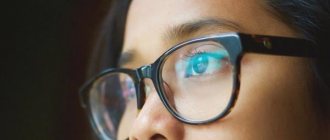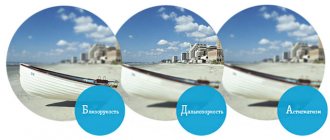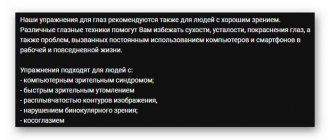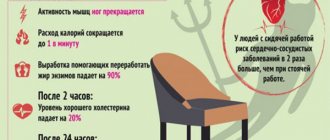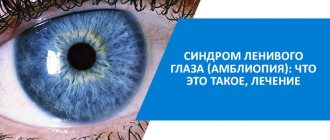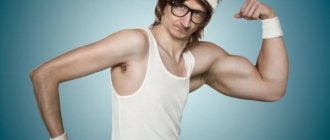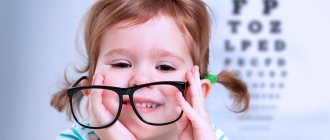Causes and signs of myopia
The main cause of myopia is genetic predisposition. With a hereditary disorder of the connective tissue structure, weakness of the posterior pole of the eye (sclera) occurs. After being refracted by the cornea, light rays are focused in front of the retina. As a result, a clear image is not formed on the retina.
In addition to hereditary predisposition, the causes of myopia can be:
- corneal diseases (keratoconus);
- spasm of accommodation (due to overstrain of the eye muscles);
- pathology of the lens (cataract).
With myopia, there is a decrease in distance visual acuity, objects become blurry, and the patient constantly tries to squint. With prolonged eye strain, headaches and pain in the eyebrow area occur. If the quality of vision in both eyes is different, pain may affect only half of the head on the side of the worse-seeing eye. Near vision remains good.
Indications and contraindications
Important point! Exercise therapy is indicated for all patients with progressive myopia within 3 - 6 D, who do not have retinal detachment or the threat of such a complication.
At the same time, therapeutic exercises for the eyes in childhood provide the greatest effectiveness. In addition, the earlier classes are prescribed, for example, for low degrees of myopia, the higher their beneficial effect. If a patient has congenital myopia, the use of exercise therapy, as practice shows, is ineffective.
The course of physical therapy for myopia should be at least three months. This period of time is divided into two periods:
- Preparatory: from 12 to 15 days.
- Training: 2.5 – 3 months.
The benefits and harms of physical therapy for myopia
About 20 years ago, any degree of myopia was an indication for limiting physical activity. To date, there are a number of studies confirming that physical therapy for myopia has a beneficial effect on the organ of vision.
A study of schoolchildren and students with moderate myopia and insufficient physical activity showed progression of myopia over a year in more than 80% of children. At the same time, in schoolchildren and students with normal physical activity during the year, an increase in the degree of myopia was found only in 10% of cases.
Cyclic exercises of moderate intensity (acceleration of the pulse to 140 beats per minute), such as walking, recreational and therapeutic swimming, for myopia lead to improved blood flow to the eyes and activate the muscles around the lens. With regular exercise, performance increases, spasm of accommodation is relieved, and the progression of myopia slows down.
High-intensity exercises (with an acceleration of the heart rate above 170 beats per minute): acrobatic gymnastics, jumping rope, lead to a deterioration in the blood supply to the organ of vision. A spasm of the arteries and capillaries occurs, causing ischemia of the muscles of the eye and retina.
To prevent the development and progression of myopia, it is necessary to perform general strengthening exercises in combination with special gymnastics for the eyes. It is important to remember that a positive effect is achieved only if the principles of exercise therapy are followed:
- Systematicity. All parts of the body should be involved in the exercises.
- Regularity.
- Gradual increase in load.
- Combine with exercises to strengthen the eye muscles.
Myopia and training in the pool
Quite often, patients wonder whether it is possible to go swimming with myopia.
Water is a universal training environment for people with poor distance vision
Doctors say that at a weak or medium stage of pathology development (up to 6 diopters) without concomitant diseases, this type of physical activity is allowed.
Moreover, some ophthalmologists even recommend swimming.
But: training should be moderate with an average form of deviation in the operation of the optical system, so that the pulse does not exceed 140 beats per minute.
Thus, there will be little strain on the eyes.
It is better to give preference to moderate intensity workouts
Important: Heavy loads with poor distance vision, especially more than 6 diopters, are prohibited, because there is a risk of retinal detachment, which already threatens blindness.
With moderate intensity and regularity of swimming lessons, you can even improve the condition of your visual organs.
Contraindications to exercise therapy and sports for myopia
In patients with mild myopia (up to 3 diopters), exercise therapy is carried out in full. With rapidly progressing myopia (more than 1 diopter per year), sports competitions, wrestling, gymnastics, strength exercises and other activities associated with high load are excluded.
Patients with uncomplicated high-degree myopia (more than 6 diopters) can perform restorative exercise of moderate intensity with mandatory monitoring of visual acuity at least once a year.
If complications develop (dystrophy, retinal tears), exercise therapy should be carried out according to an individual program. Due to the existing danger of retinal detachment and loss of vision, such patients are allowed only small loads that do not increase intraocular pressure.
The decision on the possibility of playing sports is made by an ophthalmologist after a complete ophthalmological examination of the patient.
For myopia of any degree the following are contraindicated:
- boxing;
- struggle;
- Weightlifting;
- Ski jumping;
- hockey.
For myopia of any degree without complications, the following are allowed:
- clay pigeon shooting;
- archery;
- fencing;
- swimming;
- rowing;
- ski race;
- biathlon;
- race walking;
- middle and long distance running.
For moderate and mild myopia in the absence of complications in the fundus, the following are allowed:
- gymnastics;
- cycling;
- Horseback Riding;
- water polo;
- figure skating;
- ice skating (short track);
- tennis.
For mild myopia without complications, the following are allowed:
- gymnastics;
- modern pentathlon;
- diving;
- sprinting.
Exercises and sports for people with myopia: restrictions and recommendations
Eye diseases are not a reason to give up sports
Not so long ago, doctors recommended no more than minimal physical activity for myopia.
But according to the results of recent clinical studies, this is completely wrong.
Physical exercise and playing certain sports are very important for people with myopia. They perform the following functions:
- contribute to the development of the body in a positive quality;
- activate many functions in the body.
The increased performance of the ciliary muscle and the strengthening of the sclera membrane are provoked by proper physical activity.
This is how the beam is projected
Whether or not it is permissible to engage in a certain type of physical activity depends not on the presence of the disease, but on the stage of its development.
General strengthening exercises for myopia
To strengthen the muscles of the shoulder girdle, exercise with a ball is used:
- breast transmission;
- passing behind the head with arms raised and bent at the elbows;
- throwing a tennis ball at a wall;
- playing volleyball, badminton, basketball.
To strengthen your back muscles, you can perform the following set of exercises:
- Lying on your back, arms spread to the sides. The tennis ball is passed from one hand to the other at eye level, with each hand describing a semicircle.
- Perform a cross movement with your arms (arms crossed over your chest). The eyes follow first one hand, then the other. The head remains motionless.
- Lying on your back, swing your legs towards your opposite hand. Keep your eyes on the sock.
- Sitting with straight legs and supporting your hands behind you. Raise your legs off the floor and do cross swings. Look first at one foot, then at the other. Do not turn your head behind your eyes.
- The exercise is performed from the same position. Raise your right leg up, then to the left, then lower it. Repeat the movement with your left leg.
- From the same position, first raise one leg and make several circular movements with it. Then do the same with the other leg. Keep your eyes on your socks.
Read in a separate article: Simple exercises to restore vision in case of farsightedness
Exercise therapy is used to strengthen the neck muscles:
- Standing or sitting with a straight back, tilt your head to the right and left.
- Standing or sitting with a straight back. Tilt the head forward, then return to the starting position. Tilt of the head back (throwing back) is not recommended to avoid spasm of the vessels of the cervical spine and disruption of blood flow to the brain.
- Standing or sitting with a straight back. Lower your head onto your right shoulder, move forward and in a semicircle to your left shoulder. Then - forward and in a semicircle to the right shoulder.
- Standing or sitting with a straight back. Place the palm of your right hand extended upward and bent at the elbow joint on your left ear. Slowly pull your head towards your right shoulder with your hand until the left neck muscles tense. Repeat the same on the left side.
General strengthening exercises that affect the entire body:
- swimming in the crawl, butterfly, and backstroke styles;
- moderate intensity running;
- walking at a brisk pace;
- ice skating (including roller skating);
- skiing.
Arm strength exercises for myopia
Patients often ask their ophthalmologist whether it is possible to pump their arms if they have myopia.
Power loads must be performed with caution
Pumping up the arms to develop the muscles of the forearm and trapezius is possible only at weak and medium stages of development of ophthalmological abnormalities.
This type of physical activity is not heavy initially, but in the future, so you need to find the perfect balance.
In order not to harm your eyes and get the effect of exercise, you should increase the load slower than the norm for a healthy person.
If you are still concerned about the emerging risk, it would be a good idea to consult an ophthalmologist. The doctor will already recommend further actions.
Help from a trainer is a must
With underdeveloped myopia, such physical activity is not harmful to the eyes. The main thing is not to be too zealous.
Special gymnastics for the eyes
Eye exercises help relax the muscles of the eyeball, improve blood circulation, and make it easier to work at close range. Gymnastics in a reduced volume should be performed every hour when doing work that requires eye strain (for example, when working with a computer). Full gymnastics is performed at least once a day in the morning after waking up or before going to bed.
- The exercise is performed standing, sitting or lying on your back. Close your eyes tightly for 5 seconds. Then open and relax for 5 seconds. Repeat 10 times.
- Make rapid blinking movements with your eyes for 10 seconds.
- Look at the finger of an outstretched hand. Slowly move your finger to your nose and look at it until the image begins to split into two. Then move your finger back.
- Eyes open. Slowly move your eyes up, to the side, down, to the other side. Mentally draw a square with your eyes, stopping your gaze at each of its corners. Rotate your eyes in a circle clockwise, counterclockwise. Repeat with eyes closed.
- Look with your eyes at the tip of your nose (“squint your eyes”), then straight on. Repeat 10 times.
- The exercise is performed while sitting in front of a window. Draw a red or black dot with a diameter of 5 cm on the glass. Look first at the dot for 5 seconds, then out the window at a distant object (tree, house). Repeat 10 times.
- Look at the finger of an outstretched hand with both eyes for 3 seconds. Then close your right and left eyes in turn, and look at your finger with the other eye. Repeat 10 times. The exercise is effective for restoring binocular (3D) vision if there is different visual acuity in the eyes.
After physical education, a massage of the shoulders, collar area, and light eye massage is performed. The eyelids are massaged in a circular motion (with eyes closed). The massage is performed without pressing on the eyeball. Then acupressure is performed at the exit point of the optic nerve - in the area of the eyebrows and wings of the nose.
Before starting exercise therapy, you must consult with an ophthalmologist to determine the degree of myopia and the presence of complications. Your doctor will determine whether you can play sports if you have myopia. In addition, an examination by a therapist and his conclusion about the absence of contraindications to performing certain general strengthening exercises are necessary.
Author of the article: Tatyana, specialist for the website glazalik.ru Share your experience and opinion in the comments.
Physical education and sports for myopia
Description
The results of research in recent years, especially concerning the mechanism of origin of myopia, have made it possible to re-evaluate the possibilities of physical education for this visual defect.
Limiting the physical activity of people suffering from myopia, as was recommended until recently, is recognized as incorrect. The important role of physical education in the prevention of myopia has been shown
and its progression, since physical exercise contributes to both the general strengthening of the body and the activation of its functions, as well as increasing the performance of the ciliary muscle and strengthening the scleral membrane of the eye.
I. V. Sukhinenko (1980) found that girls 15-17 years old with moderate myopia are significantly behind their peers with emmetropia and hypermetropia in terms of physical fitness. They experience a significant decrease in blood flow in the vessels of the eye and a weakening of accommodative ability. Cyclic physical exercises (running, swimming, skiing) of moderate intensity (pulse 100-140 beats/min) have a beneficial effect on hemodynamics and accommodative ability of the eyes
, causing a reactive increase in blood flow in the eye some time after the load and an increase in the performance of the ciliary muscle. After performing cyclic exercises of significant intensity (pulse 180 beats/min and higher), as well as exercises on gymnastic apparatus, jumping rope, and acrobatic exercises, severe ocular ischemia, which persists for a long time, and deterioration in the performance of the ciliary muscle are noted. Testing of the method of physical education of children with medium myopia, taking into account the above effects of physical exercise, showed that the use of this method helps prevent the progression of myopia: after a year in the experimental group, refraction decreased in 37.2% of cases, remained at the same level in 53.5 % and increased in 9.3%, whereas in the control group this was observed in 2.4; 7.4 and 90.2% of cases, respectively.
Research by E. and Livado (1977) made it possible to establish that a decrease in the general motor activity of schoolchildren with increased visual load can contribute to the development of myopia. Physical exercises of a general developmental nature in combination with special exercises for the ciliary muscle have a positive effect on the functions of the myopic eye
. Based on the results of the research, a method of physical therapy for schoolchildren with myopia has been developed and its effectiveness has been shown when used as part of a set of measures to prevent myopia and its progression. Yu. I. Kurpan (1975, 1979) substantiated the methodology of physical education for students suffering from myopia.
The peculiarity of physical education for schoolchildren and students, which helps prevent myopia and its progression, is that in addition to general developmental exercises, special exercises are also included
, improving blood supply to the tissues of the eye and the activity of the eye muscles, primarily the ciliary muscle.
Special exercises
A set of exercises has been developed [Avetisov E. S., Livado E. I., 1977], intended for people whose work involves prolonged viewing of closely located small objects. Here is an example set of such exercises:
.
1
. Starting position (ip.) - sitting. Close your eyes tightly for 3-5 seconds, and then open them for 3-5 seconds. Repeat 6-8 times. Exercise strengthens the muscles of the eyelids, improves blood circulation and relaxes muscles.
2
. I.p. - sitting. Blink quickly for 1-2 minutes. Exercise helps improve blood circulation in the eyelids.
3
. I.p. - standing. Look straight ahead for 2-3 seconds, look at the finger of your outstretched right hand, located along the midline of the face at a distance of 25-30 cm from the eyes, and look at it for 3-5 seconds, lower your hand. Repeat 10-12 times. Exercise reduces fatigue and facilitates visual work at close range.
4
. I.p. - standing. Stretch your hand forward, look at the end of the finger of the outstretched hand, located along the midline of the face, slowly bring the finger closer, without taking your eyes off it, until the finger begins to double. Repeat 6-8 times. The exercise facilitates visual work at close range.
5
. I.p. - sitting. Close your eyelids and massage them with circular movements of your finger. Repeat for 1 minute. Exercise relaxes muscles and improves blood circulation in the eyelids.
6
. I.p. - standing. Place the finger of the right hand along the midline of the face at a distance of 25-30 cm from the eyes, look with both eyes at the end of the finger for 3-5 s, cover the left eye with the palm of the left hand for 3-5 s, remove the palm, look with both eyes at the end of the finger 3 -5 s, place the finger of the left hand along the midline of the face at a distance of 25-30 cm from the eyes, look with both eyes at the end of the finger for 3-5 s, cover the right eye with the palm of the right hand for 3-5 s, remove the palm, look with both eyes at the end of the finger 3-5 s. Repeat 5-6 times. Exercise strengthens the muscles of both eyes (binocular vision).
7
. I.p. - standing. Move your hand to the right side, slowly move the finger of your half-bent hand from right to left and, without moving your head, follow your finger with your eyes; slowly move the finger of your half-bent hand from left to right and, without moving your head, follow your finger with your eyes. Repeat 10-12 times. The exercise strengthens the horizontal eye muscles and improves their coordination.
8
. I.p. - sitting. With three fingers of each hand, lightly press on the upper eyelid, and after 1-2 seconds, remove your fingers from the eyelids. Repeat 3-4 times. Exercise improves the circulation of intraocular fluid.
The following general exercises help improve the performance of the ciliary muscle:
.
1
. Pass the ball (volleyball, basketball, medicine) from the chest to a partner standing at a distance of 5-7 m. Repeat 12-15 times.
2
. Passing the ball to a partner from behind the head. Repeat 10-12 times.
3
. Passing the ball to a partner with one hand from the shoulder. Repeat 7-10 times with each hand.
4
. Throw the ball up with both hands and catch it. Repeat 7-8 times.
5
. Throw the ball up with one hand and catch it with the other (or both). Repeat 8-10 times.
6
. Hit the ball hard on the floor, let it bounce and catch it with one or two hands. Repeat 6-7 times.
7
. Throws a tennis ball at a wall from a distance of 5-8 m. Repeat 6-8 times with each hand.
8
. Throwing a tennis ball at a target. Repeat 6-8 times with each hand.
9
.
Throw a tennis ball so that it bounces off the floor and hits the wall, and then catch it. Repeat 6-8 times with each hand. 10
. Throws the ball into a basketball hoop with one or two hands from a distance of 3-5 m. Repeat 12-15 times.
11
. Overhead pass to a volleyball partner. Perform for 5-7 minutes.
12
. Low pass of the volleyball to a partner. Perform for 5-7 minutes.
13
. Serving the volleyball through the net (straight bottom, side bottom). Repeat 10-12 times.
14
. Playing badminton over a net and without it - 15-20 minutes.
15
. Table tennis game - 20-25 min.
16
. Playing tennis against the wall and through the net - 15-20 minutes.
17
. Volleyball game - 15-20 min.
18
. Kicks with a soccer ball against the wall and into squares from a distance of 8-10 m - 15-20 min.
19
. Passing a soccer ball in pairs (pass) at a distance of 10-12 m - 15-20 minutes.
20
. Throwing the hoop forward and giving it reverse rotation.
Below are general developmental exercises performed in combination with eye movements. When performing them, it is recommended not to turn your head and perform eye movements slowly
.
1
. I.p. - lying on your back, arms to the sides, tennis ball in your right hand. Bring your hands together in front and transfer the ball to your left hand. Return to i.p. Bring your hands together in front and transfer the ball to your right hand. Return to i.p. Look at the ball. Repeat 10-12 times.
2
. I.p. - lying on your back, arms along your body, a ball in your right hand. Raise your hand up (behind your head) and, lowering it, transfer the ball to the other hand. Same with the other hand. Look at the ball. Repeat 5-6 times with the other hand. When raising your arms, inhale; when lowering, exhale.
3
. I.p. - lying on your back, arms forward - to the sides. Perform cross movements with straight arms for 15-20 seconds. Watch the movement of the hand of one, then the other hand. Breathing is voluntary.
4
. I.p. - Same. Swing one leg to the opposite hand. Repeat 6-8 times with each leg. Look at the sock. Swing quickly. During the swing, exhale.
5
. I.p. - lying on your back, hold a volleyball in your arms raised forward. Swing your leg with your toe touching the ball. Repeat 6-8 times with each leg. Look at the sock. During the swing, exhale.
6
. I.p. - lying on your back, arms forward. Perform cross movements with your arms, lowering and raising them. Watch the brush of one hand, then the other. Perform for 15-20 seconds.
7
. I.p. - lying on your back, in your right hand, raised forward, a tennis ball. Perform circular movements with your hand back and forth for 20 seconds. Look at the ball. Change direction of movement after 5 s.
8
. I.p. - sitting on the floor, support your hands behind you, straight legs slightly raised. Perform cross movements for 15-20 seconds. Look at the toe of one foot. Don't turn your head. Do not hold your breath.
9
. I.p. - Same. Alternately raise and lower your legs. Perform for 15-20 seconds. Look at the toe of one foot.
10
. I.p. - sitting on the floor, supporting yourself with your hands behind you. Swing your right leg up and to the left, return to IP. Do the same with your left foot up and to the right. Repeat 6-8 times with each leg. Look at the sock.
11
. I.p. - Same. Move your right leg to the right, return to standing position. Do the same with the other foot to the left. Look at the sock. Repeat 6-8 times with each leg.
12
. I.p. - the same, straight leg slightly raised. Perform circular movements with your leg in one direction and the other. Same with the other leg. Perform 10-15 with each leg. Look at the sock.
13
. I.p. - the same, but both legs are raised. Perform circular movements in one direction and the other for 10-15 seconds. Look at the socks.
14
. I.p. - standing, hold the gymnastic stick down. Raise the stick up, bend over - inhale, lower the stick - exhale. Look at the stick. Repeat 8-12 times.
15
. I.p. - Same. Sit down and lift the gymnastic stick up, return to the standing position. Look at the stick. Repeat 8-12 times.
16
. I.p. - standing, hold dumbbells in front. Circular movements of the arms in one direction and the other - 15-20 s. Look first at one dumbbell, then at the other. Perform circular movements for 5 seconds in one direction, then 5 seconds in the other.
17
. I.p. - Same. Raise one hand, lower the other, then vice versa - 15-20 s. Look first at one dumbbell, then at the other.
18
. I.p. - standing, dumbbells in lowered hands. Raise the dumbbells up, then lower them. Look first at the right dumbbell, then at the left. Turn your gaze back to the right dumbbell. Perform eye movements in one direction and the other for 15-20 s. Change the direction of eye movement after 5 s.
19
. I.p. - standing, hoop in outstretched hand. Rotate the hoop in one direction, then in the other direction for 20-30 seconds. Look at the brush. Perform with one and the other hand.
20
. I.p. - standing, look only forward at any object. Turn your head to the right, then to the left. Repeat 8-10 times in each direction.
21
. I.p. - Same. Raise your head, then lower it, without changing your gaze. Repeat 10 times. Look at some object.
Special exercises are alternated with exercises to strengthen the muscles of the neck and back, the anterior abdominal wall, as well as breathing exercises. For persons with high myopia, it is not advisable to prescribe exercises with long and strenuous transitions from a sitting position to a lying position and back.
Outdoor games
- an excellent means of training the body and increasing the emotional state of the players. It is necessary to exclude games in which there is a risk of collision between players, blows to the face and head, as well as games that require a lot of tension and straining.
It is advisable to play games with short, fast running
(10-15 m), passing and catching the ball, throwing at a wall or target. In one lesson, you can use three to four games, with each repetition 2-3 times. If the players are tired, it is recommended to do breathing exercises between individual games. Here is a list of outdoor games that can be used in physical education classes.
1
. A relay race with running, throwing the ball to the side and then catching the ball.
2
. Relay race with passing the ball in opposing columns.
3
. Games with throwing a ball at a target.
4
. Games involving throwing a bag of sand onto a chair or into a square drawn on the floor.
5
. Games involving throwing a tennis ball into a basket (bucket).
6
. A shuttle game involving throwing a medicine ball.
7
. Ball race in a circle.
Physical education for schoolchildren with myopia.
The leading place in the system of physical education for secondary school students is occupied by physical education lessons. However, they do not always provide the necessary physical development of schoolchildren who have a state of physical inactivity. In this regard, additional forms of physical education acquire special importance: morning hygienic gymnastics, gymnastics before classes, physical education minutes in class, games during breaks, extracurricular sports activities. Various forms of physical education must be used to reorganize the motor mode of a child who sits at a desk for 4-5 hours. A decrease in motor activity also adversely affects the accommodative apparatus of the eye.
Compulsory physical education classes for schoolchildren are carried out in three groups: basic, preparatory and special.
To the main group
Students with uncorrected visual acuity below 0.5 in the better seeing eye, or with hypermetropic or myopic refraction of more than 3 diopters are not admitted.
In the preparatory group
The main physical education program is carried out for 1 - 1.5 years. Sports training and competitions are excluded. Students with hypermetropia and myopia greater than 6.0 diopters, regardless of visual acuity, are not allowed to attend classes in this group.
Students with hypermetropia and myopia more than 6.0 diopters
Regardless of visual acuity, as well as those with chronic and degenerative eye diseases, they are treated in a special group according to an individual program.
The selection of schoolchildren into each of these groups according to the state of the organ of vision is carried out in accordance with the instructions approved by the USSR Ministry of Health on November 15, 1974 (Table 40).
Table 40.
Restrictions on physical education classes for schoolchildren based on the state of the organ of vision
For schoolchildren suffering from myopia and included in a special group, special exercises such as physical therapy have been developed.
Considering that physical education can not only help to slow down or delay the progression of existing myopia, but also prevent its occurrence, it is advisable to include a number of special exercises in the general complex of physical exercises
for all schoolchildren studying in the main and preparatory groups.
Special exercises for the eyes in a physical education lesson must be performed together with general developmental and corrective exercises. When performing many general developmental exercises, especially those related to hand movements, you can simultaneously perform exercises for the ciliary muscle and the external muscles of the eye, fixing your gaze on the hand or object being held. These exercises must be performed so that the function of the accommodative apparatus does not decrease
and adaptation to increased visual load would take place under more favorable conditions.
In addition to physical education lessons, active rest for the eyes is necessary in general education lessons.
. 25-30 minutes after the start of the lesson, schoolchildren are asked to blink their eyes quickly for 20-30 seconds, then close their eyes and sit quietly for 1 minute, leaning back on the desk.
Particular attention should be paid to schoolchildren in grades 1–4
, whose eyes during this period adapt to the increasing visual load and at the same time their motor activity sharply decreases. In this regard, in physical education lessons in grades 1–4 for all schoolchildren, in addition to general developmental and corrective exercises, it is recommended to include 2–3 eye exercises that help strengthen the accommodative apparatus. For elementary school students with myopia who are sent to a preparatory or special group, it is advisable to recommend, in addition to physical education lessons, physical therapy classes.
In grades 5-7 for schoolchildren
Those suffering from myopia up to 6.0 diopters, in the absence of pathological changes in the fundus, are allowed to engage in physical education to a fairly full extent. They will especially benefit from lessons that involve sports games, swimming and tourism.
For schoolchildren with myopia of more than 6.0 diopters
Those studying in grades 5-7
need an individual approach
. If such schoolchildren do not have pathological changes in the fundus and myopia does not progress, then they can be allowed to participate in classes in a special group, excluding high-intensity exercises, as well as exercises associated with shaking the body (jumping, skipping) or requiring great tension (stands, stops, hangs, pull-ups on the bar, lifting weights).
In grades 8-10
Due to the increase in the volume and intensity of the educational process, the lack of free time, and a further decrease in physical activity, the importance of physical education in the prevention of myopia and its progression increases even more.
For young men with myopia up to 6.0 diopters, it is necessary to exclude exercises on the crossbar
in the gymnastics program, overcoming an obstacle course, as well as classical wrestling. Athletics, skiing, swimming and sports games are carried out without restrictions; strength exercises on the crossbar, pull-ups and lifting from a hanging position are excluded; they can be replaced by climbing a rope using the legs.
High school students
with uncomplicated myopia of more than 6.0 diopters can participate in a special group or physical therapy group. For schoolchildren with complicated myopia, individual physical education classes are recommended, the methodology of which should be determined together with an experienced ophthalmologist.
Physical therapy classes include both general developmental and special exercises in a ratio of 1:2; 1:3.
Considering that people suffering from myopia are more likely to have poor posture, weakness of the connective tissue system, as well as a tendency to tilt the torso and head excessively forward when visually working at close range, great importance should be given to exercises to strengthen the extensor muscles and corrective exercises
.
Breathing exercises also play an important role.
, enhancing pulmonary ventilation, blood circulation, improving redox processes in the body. In addition, breathing exercises serve as a means of periodically reducing physical activity.
When constructing a method of physical therapy, it is necessary to observe all its basic principles:
• systematic impact of physical exercises and the sequence of their application;
• regularity of impacts;
• long-term use of physical exercises;
• gradual increase in physical activity throughout both a separate procedure and the entire treatment course;
• individualization of physical exercises depending on the age, gender, health status of those involved;
• a combination of general and special training during the course of treatment.
It is advisable to divide the course of physical therapy for schoolchildren suffering from myopia into two periods - preparatory and main (training)
. The preparatory period usually lasts 12-15 days. It is characterized by the implementation of predominantly general developmental exercises and a gradual increase in special training of the extensors of the head and torso. Particular attention is paid to teaching proper breathing. The ratio of breathing and general developmental exercises should first be 1:1, then 1:2.
Full breathing using the entire breathing apparatus should be considered correct.
. You need to start learning by mastering static breathing, and then gradually complicate various combinations of breathing with movements. Dynamic breathing exercises should be simple in construction, they should be performed freely, without effort.
Special exercises performed during this period include breathing and corrective exercises.
, as well as exercises to strengthen the arches of the feet. The exercises are performed in the following starting positions: lying, sitting, standing. Corrective exercises are mainly carried out in conditions of unloading the spine - lying down. The pace of the exercises is slow and medium. They use gymnastic equipment, sticks, balls, medicine balls, etc.
In addition to gymnastic exercises
, use outdoor games and individual elements from sports games for general health effects, as well as increasing emotional tone, which is important in childhood. Sports games are played in the starting position sitting and standing. Games involving passing the ball or shooting a ball into a basketball basket include elements of competition.
The main period lasts 2.5 months
. Against the background of general developmental, breathing and corrective exercises, special exercises are used to strengthen the external muscles of the eye and the ciliary muscle. These exercises must be strictly dosed. At first they are repeated 2 times, and then the number of repetitions is increased to four to six. It is advisable to perform exercises for the external muscles of the eye simultaneously with general developmental exercises in the initial position lying or standing at the gymnastic wall, which is the most optimal for maintaining correct posture.
At the end of the course of treatment, schoolchildren receive individual recommendations on general and visual conditions, and on conducting a complex of therapeutic exercises. It is important that your child continues to do the recommended exercises at home. At school, children are not exempt from physical education.
Physical education of students with myopia
. A significant proportion of students suffer from myopia. As one progresses to senior years, there is a tendency for its progression. This is obviously caused by high visual load, insufficient physical activity, and violation of hygienic working and living conditions.
When distributing students with myopia into study groups for physical education classes, taking into account medical examination data, one should be guided by the above restrictions for physical education classes for schoolchildren based on the state of the organ of vision.
The following forms of physical education are used:
: compulsory and elective classes; physical culture events; independent exercises, including morning hygienic exercises and measures to harden the body, as well as special exercises for the ciliary muscle.
Students with mild myopia
are included in the main group and can engage in physical education in the preparatory department or in the sports improvement department. Software requirements are fulfilled by them without restrictions. Playing sports is useful. Constantly switching vision when playing volleyball, basketball, tennis from close to far and back helps to enhance accommodation and prevent the progression of myopia.
If you have moderate myopia
students are included in the preparatory medical group; they must engage in physical education in the preparatory educational department. Practical classes with them should be conducted separately from students of the main medical group. It is advisable to introduce some restrictions into the program requirements for them: exclude jumps from a height of more than 1.5 m, exercises that require great and prolonged physical stress. The degree of neuromuscular tension and the total load during physical education should be somewhat lower than that of students from the main medical group.
For students of the preparatory medical group, along with educational classes, it is also necessary to provide independent classes, including special exercises for the eye muscles or physical therapy classes.
If it is not possible to separate students with moderate myopia into an independent group, then it is advisable to divide them into two subgroups
: students with myopia 3.5-4.5 diopters are included in the preparatory group, and students with myopia 5.0-5.5 diopters are included in the special medical group.
Students with high myopia (6.0 diopters or more)
should engage in physical education only in a special medical department. The following forms of physical education are used: a) compulsory and elective classes; b) independent exercises, including morning hygienic exercises and measures to harden the body, exercises to increase the level of general and strength endurance, as well as training the ciliary muscle. In addition, physical therapy exercises can be recommended.
It is better to form groups of students from the same course (stream). The number of such groups should be 12 people. If it is not possible to separate students with myopia into a separate group, then it is advisable to combine them with students suffering from respiratory diseases.
Students with myopia up to 8.0 diopters
who have no pathological changes in the fundus, with good physical fitness, can perform almost all the exercises from the physical education program for practically healthy students. In addition to the features of physical education, which were indicated above, it is also important to take into account that for students of this group suffering from myopia, exercises on a high and medium balance beam such as jumps and dismounts, vaults over apparatus, somersaults and headstands, exercises on a gymnastics table are undesirable. wall at a height of more than 2 m, jumping from a swing bridge, jumping into the water upside down, prolonged exercises with a skipping rope, as well as other exercises that may result in falls and sudden shocks to the body. In this group, breathing and corrective exercises, as well as special eye exercises, should be used more widely.
It has been established that physical education classes, held 2 times a week, do not cause significant changes in the physical development of students and that throughout most of the academic year they experience the phenomenon of hypokinesia. In this regard, independent physical education is necessary.
The following forms of independent study are recommended:
:
• daily performance of morning hygienic gymnastics and procedures for hardening the body;
• performing general developmental exercises as instructed by the teacher;
• performing exercises to improve accommodative ability.
Before starting to organize independent physical education classes, it is important to convince students of their necessity and benefits. For clarity, the results of a medical examination, anthropometric measurements and assessment of students’ physical fitness are used.
For myopia 8.5 diopters
and more without affecting the condition of the fundus, students are recommended to engage in physical therapy. In addition to therapeutic exercises, students need to conduct independent exercises, including morning hygienic exercises and procedures for hardening the body.
Therapeutic gymnastics classes are carried out during non-school hours in a group method (6-8 people per group) at least 2 times a week. The duration of classes is from 15 to 30 minutes, depending on the condition of the eyes and the level of physical development of the students.
Therapeutic gymnastics classes begin with walking and breathing exercises
. This is followed by general developmental exercises for the muscles of the limbs and torso with passing objects, throwing a medicine ball weighing 2-3 kg, simple exercises at the gymnastic wall, dance elements, slow running on toes and other exercises. The classes are completed with slow walking and breathing exercises to relax the muscles.
During physical therapy classes, it is necessary to completely eliminate all jumping exercises.
, sudden movements of the body, sudden bending of the body and squats. The degree of neuromuscular tension should be average. Exercises should not cause fatigue, so general developmental exercises alternate with breathing exercises.
Myopia and sports
. Physical exercise and sports are the main means of promoting health and maintaining good performance at any age. Sports are characterized by high emotionality, competitive nature, and the desire to achieve the highest results. However, when practicing many sports (especially at the high level), athletes experience significant training loads in terms of volume and intensity, and they are required to exert extreme physical and mental strength. In this regard, it is very important to choose the right sport for people with myopia and ensure systematic medical monitoring of the condition of their organ of vision. Sports training can have a beneficial effect on the condition of the eyes with myopia and help stabilize it, but at the same time it can also have a very adverse effect on the organ of vision and lead to complications of myopia. It all depends on the degree of myopia, the condition of the eyes, as well as the specifics of the sport and the intensity of sports activities.
For uncomplicated stationary myopia
It is possible and beneficial to engage in some sports. If playing a given sport is incompatible with wearing glasses and is possible without optical correction, then glasses may be removed during training. Some sports require high visual acuity and at the same time you cannot use glasses. In such cases, contact correction is advisable.
With progressive myopia
, especially complicated, sports associated with great physical stress, rapid movement of the body and the possibility of shaking are contraindicated.
In table 41
Table 41.
Main contraindications to sports for people with myopia
the main contraindications to sports for people with myopia are given, and recommendations are given on the use of optical correction during sports activities.
In the system of medical support for physical education movement, an important place is occupied by the problem of studying analyzer systems, primarily the organ of vision. Particular difficulties arise in the prognostic assessment of myopia.
. As a result, ophthalmologists often find themselves in a difficult situation when the change in refraction exceeds the permissible gradations, especially among highly qualified athletes, whose training often uses extreme loads. The importance of this issue for modern sports lies in the fact that in recent years, athletes suffering from myopia have become increasingly common in big-time sports. In this regard, there is an urgent need to clarify the tactics of a sports doctor for this type of pathology of the organ of vision.
It should be noted that the problem under consideration has two aspects: the first is myopia and mass sports, the second is myopia and big sports
. According to the current situation, during the initial medical examination, persons with myopia of more than 3.0 diopters are not allowed to play sports, and if myopia during sports activities increases to 6.0 diopters, the athlete is advised to stop exercising. However, if at the initial stage of sports training the issue of preventing persons with myopia from training is resolved relatively simply, then the issue of the fate of Olympic reserve athletes with myopia requires careful study. We believe that this issue needs to be resolved on a purely individual basis. In this case, it is important to take into account the sports qualifications and prospects of the athlete. There are many examples of athletes with moderate myopia successfully defending the sporting honor of our Motherland in the international arena. Thus, myopia did not prevent weightlifters Yu. Vlasov and Yu. Zaitsev from becoming Olympic champions, and figure skater Yu. Ovchinnikov from becoming a European Championship medalist. Currently, the national and reserve teams include athletes with mild and moderate myopia. Sports doctors need to pay attention to the state of the visual organ of these athletes and carry out the necessary rehabilitative treatment. Ophthalmologists should examine them at least once every 3 months. The issue of using optical correction during sports activities and competitions is decided depending on the type of sport and what kind of correction is familiar to the athlete. The sports doctor must fully use all means of preventing the progression of myopia, including special exercises for the external and internal muscles of the eye.
The above table should be used primarily when deciding whether beginner athletes with myopia can play sports.
. This table can also serve as a guide when resolving this issue in relation to high-class athletes using an individual approach.
—-
Article from the book: Myopia | E. S. Avetisov
